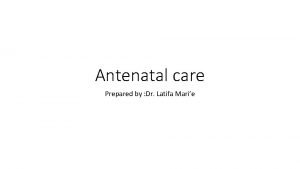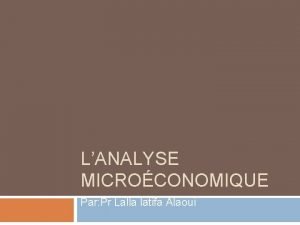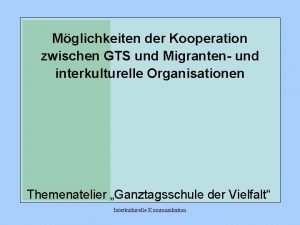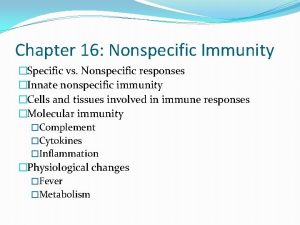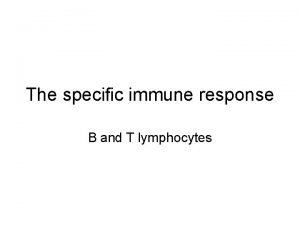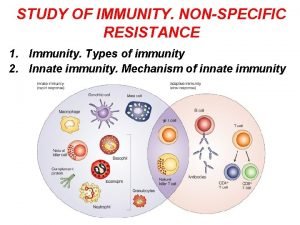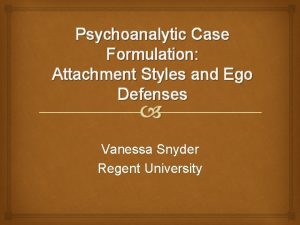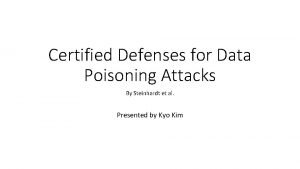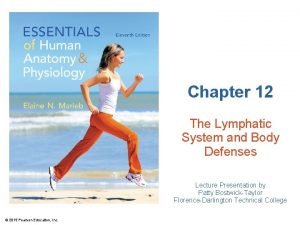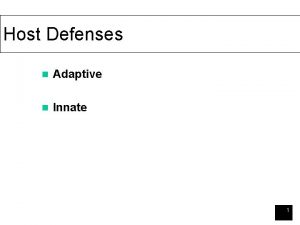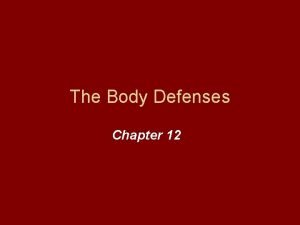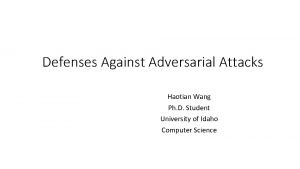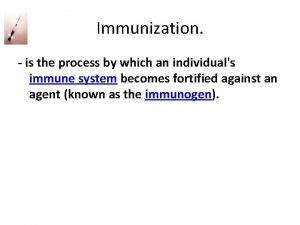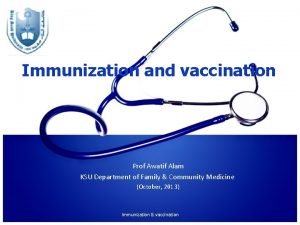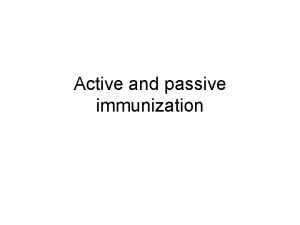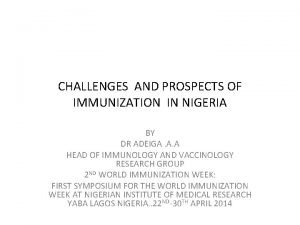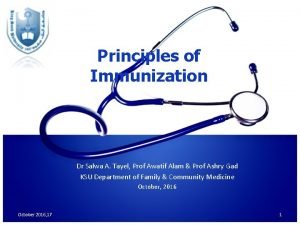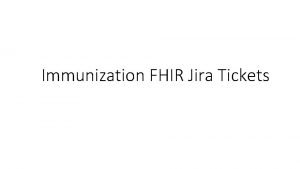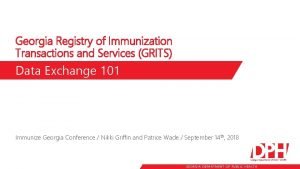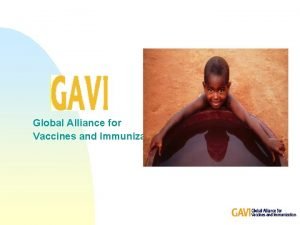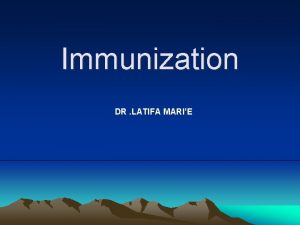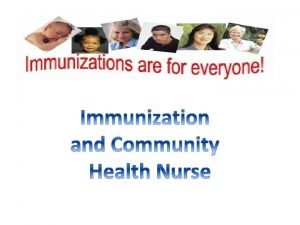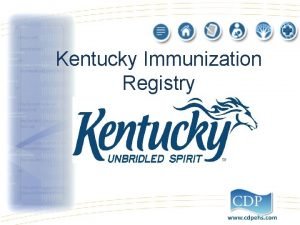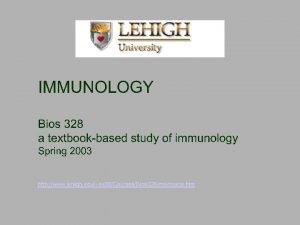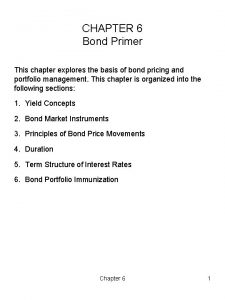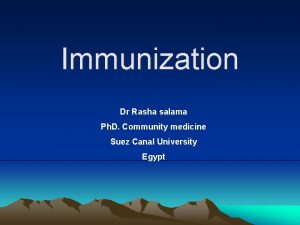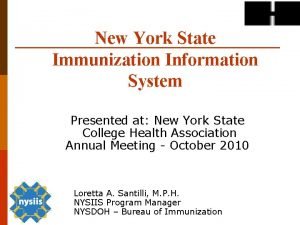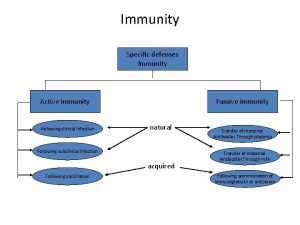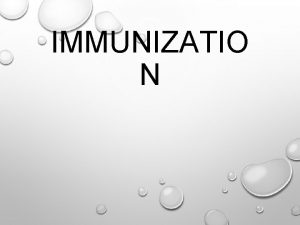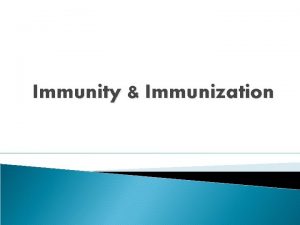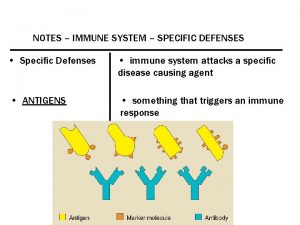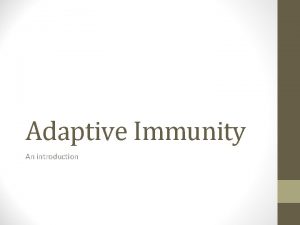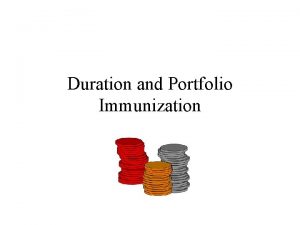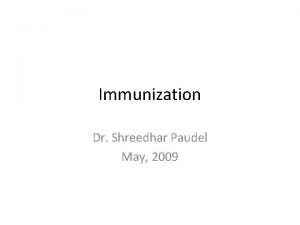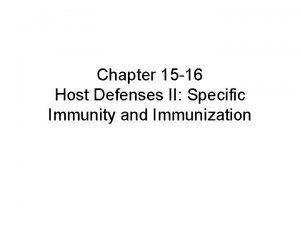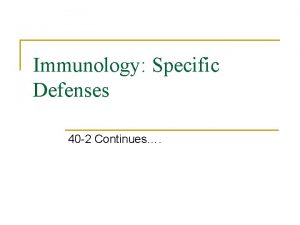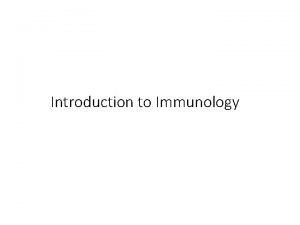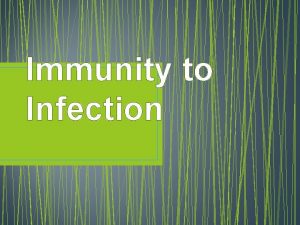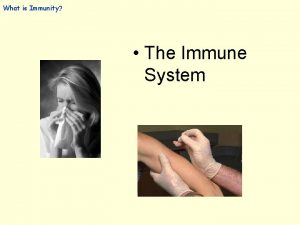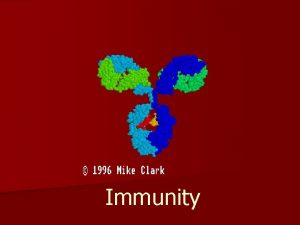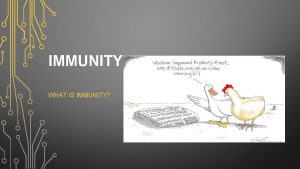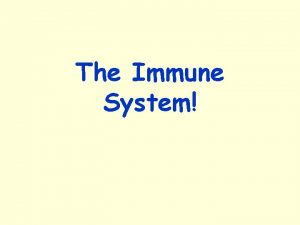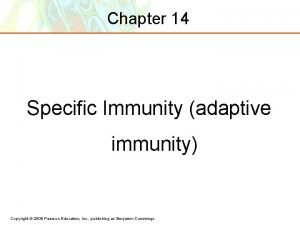Immunization DR LATIFA MARIE Immunity Specific defenses Immunity




































- Slides: 36

Immunization DR. LATIFA MARI’E

Immunity Specific defenses Immunity Active immunity Following clinical infection Passive immunity natural Following subclinical infection acquired Following vaccination Transfer of maternal Antibodies Through placenta Transfer of maternal Antibodies Through milk Following administration of Immunoglobulin or antiserum

Active immunity • Resistance developed in response to stimulus by an antigen (infecting agent or vaccine) and is characterized by the production of antibodies by the host.

Passive immunity • Immunity conferred by an antibody produced in another host. It may be acquired naturally or artificially (through an antibody containing preparation).

Immunizing agents vaccines immunuglobulins antisera

Immunoglobulins • There are 5 major classes: Ig. M, Ig. A, Ig. G, Ig. E, Ig. D. • Two types of immunoglobulin preparations are available for passive immunization: – Normal human immunoglobulin – Specific (hyper immune) human immunoglobulin

Antisera or antitoxins • These are materials prepared in animals or non human sources such as horses.

Vaccination • Vaccination is a method of giving antigen to stimulate the immune response through active immunization. • A vaccine is an immuno biological substance designed to produce specific protection against a given disease. • A vaccine is “antigenic” but not “pathogenic”.

Types of vaccines • • • Live vaccines Attenuated live vaccines Inactivated (killed vaccines) Toxoids Polysaccharide and polypeptide (cellular fraction) vaccines • Surface antigen (recombinant) vaccines.

Live vaccines • Live vaccines are made from live infectious agents without any amendment. • The only live vaccine is “Variola” small pox vaccine, made of live vaccinia cow pox virus (not variola virus) which is not pathogenic but antigenic, giving cross immunity for variola.

Live attenuated (avirulent) vaccines • Virulent pathogenic organisms are treated to become attenuated and avirulent but antigenic. They have lost their capacity to induce full blown disease but retain their immunogenicity. • Live attenuated vaccines should not be administered to persons with suppressed immune response due to: – – – Leukemia and lymphoma Other malignancies Receiving corticosteroids and anti metabolic agents Radiation pregnancy

Inactivated (killed) vaccines • Organisms are killed or inactivated by heat or chemicals but remain antigenic. They are usually safe but less effective than live attenuated vaccines. The only absolute contraindication to their administration is a severe local or general reaction to a previous dose.

Toxoids • They are prepared by detoxifying the exotoxins of some bacteria rendering them antigenic but not pathogenic. Adjuvant (e. g. alum precipitation) is used to increase the potency of vaccine. • The antibodies produces in the body as a consequence of toxoid administration neutralize the toxic moiety produced during infection rather than act upon the organism itself. In general toxoids are highly efficacious and safe immunizing agents.

Polysaccharide and polypeptide (cellular fraction) vaccines • They are prepared from extracted cellular fractions e. g. meningococcal vaccine from the polysaccharide antigen of the cell wall, the pneumococcal vaccine from the polysaccharide contained in the capsule of the organism, and hepatitis B polypeptide vaccine. • Their efficacy and safety appear to be high.

Surface antigen (recombinant) vaccines. • It is prepared by cloning HBs. Ag gene in yeast cells where it is expressed. HBs. Ag produced is then used for vaccine preparations. • Their efficacy and safety also appear to be high.

Types of vaccines Live Killed Attenuated Inactivated vaccines Toxoids Cellular fraction vaccines • Small pox variola vaccine • BCG • Typhoid oral • Plague • Oral polio • Yellow fever • Measles • Mumps • Rubella • Intranasal Influenza • Typhus • varicela • Diphtheria • Tetanus • Meningococcal • Hepatitis B polysaccharide vaccine • Pneumococcal polysaccharide vaccine • Hepatitis B polypeptide vaccine • Typhoid • Cholera • Pertussis • Plague • Rabies • Salk polio • Intra muscular influenza • Japanise encephalitis Recombinant vaccines

Routes of administration • Deep subcutaneous or intramuscular route (most vaccines) • Oral route (sabine vaccine, oral BCG vaccine) • Intradermal route (BCG vaccine) • Scarification (small pox vaccine) • Intranasal route (live attenuated influenza vaccine)

Scheme of immunization • Primary vaccination – One dose vaccines (BCG, variola, measles, mumps, rubella, yellow fever) – Multiple dose vaccines (polio, DPT, hepatitis B) • Booster vaccination To maintain immunity level after it declines after some time has elapsed (DT, MMR).

HAZARDS OF IMMUNIZATION • No immune response is entirely free from the risk of adverse reactions or remote squeal. The adverse reactions that may occur may be grouped under the following heads: 1. 2. 3. 4. 5. 6. Reactions inherent to inoculation Reactions due to faulty techniques Reactions due to hypersensitivity Neurological involvement Provocative reactions Others

• 1. Reactions inherent to inoculation: These may be local general reactions. The local reactions may be pain, swelling, redness, tenderness and development of a small nodule or sterile abscess at the site of injection. • The general reactions may be fever, malaise, headache and other constitutional symptoms. Most killed bacterial vaccines (e. g. , typhoid) cause some local and general reactions. Diphtheria and tetanus toxoids and live polio vaccine cause little reaction.

• 2. Reactions due to faulty techniques: Faulty techniques may relate to • faulty production of vaccine (e. g. inadequate inactivation of the microbe, inadequate detoxication), • too much vaccine given in one dose, • improper immunization site or route, • vaccine reconstituted with incorrect diluents, • wrong amount of diluent used, • drug substituted for vaccine or diluent, • vaccine prepared incorrectly for use (e. g. , an adsorbed vaccine not shaken properly before use), • vaccine or dliluent contaminated, • vaccine stored incorrectly, • contraindications ignored (e. g. a child who experienced a severe reaction after a previous dose of DPT vaccine is immunized with he same vaccine), • reconstituted vaccine of one session of immunization used again at the subsequent session.

• Use of improperly sterilized syringes and needles carry the hazard of hepatitis B virus, and staphylo and streptococcal infection

• 3. Reactions due to hypersensitivity: • Administration of antisera (e. g. , ATS) may occasionally give rise to anaphylactic shock and serum sickness. Many viral vaccines contain traces of various antibiotics used in their preparation and some individuals may be sensitive to the antibiotic which it contains. Anaphylactic shock is a rare but dangerous complication of injection of antiserum. There is bronchospasm, dyspnoea, pallor, hypotension and collapse. • The symptoms may appear within a few minutes of injection or may be delayed up to 2 hours. Some viral vaccines prepared from embryonated eggs (e. g. , influenza) may bring about generalized anaphylactic reactions. Serum sickness is characterized by symptoms such as fever, rash, oedema and joint pains occurring 7 12 days of injection of antiserum.

• 4. Neurological involvement: • Neuritic manifestations may be seen after the administration of serum or vaccine. The well known examples are the post vaccinial encephalitis and encephalopathy following administration of anti rabies and smallpox vaccines. • Guillain Barre syndrome in association with the swine influenza vaccine is another example.

• 5. Provocative reactions: • Occasionally following immunization there may occur a disease totally unconnected with the immunizing agent (e. g. , provocative polio after DPT or DT administration against diphtheria). • The mechanism seems to be that the individual is harboring the infectious agent and the administration of the vaccine shortens the incubation period and produces the disease or what may have been otherwise only a latent infection is converted into a clinical attack.

• 6. Others: • These may comprise damage to the fetus (e. g. , with rubella vaccination); displacement in the age distribution of a disease (e. g. , a potential problem in mass vaccination against measles, rubella and mumps).

Vaccination Coverage • Vaccination coverage is the percent of at risk or susceptible individuals, or population who have been fully immunized against particular diseases by vaccines or toxoids. To be significantly effective in prevention of disease on mass or community level at least a satisfactory proportion (75% or more) of the at risk population must be immunized.

Application of active immunization • Infants and children expanded immunization program (schedule) • Active immunization for adult females • Vaccination for special occupations • Vaccination for special life styles • Vaccination for special environmental situations • Vaccinations for special health status persons • Vaccinations in travel • Vaccines against bioterrorism

Compulsory (obligatory) vaccination for infants, and booster vaccination for children (Expanded immunization program) • See local schedule of vaccination • Note (children failing to complete childhood vaccination schedule)

Active immunization for adult females • MMR vaccine is given in adolescence before or after marriage, but not during pregnancy and has to be before 3 months of conception • Tetanus toxoid in pregnancy to prevent tetanus neonatorum in the newborn. In the first pregnancy on the third month and after 1 month. The third dose in the second pregnancy, and the fourth on the third pregnancy with a maximum of 5 doses. If 10 years elapse, and then pregnancy occurs, the doses are given from the start. • Live attenuated vaccines should not be given during pregnancy.

Vaccination for special occupations • Health care workers: hepatitis B, influenza, MMR, polio • Public safety personnel (police, fire fighters) and staff of institutions for the developmentally disabled: hepatitis B, influenza • Vets and animal handlers: rabies, plague and anthrax • Food handlers: TAB • Military troops and camp dwellers: pneumococcal, meningococcal, influenza, BCG (for non reactors), tetanus

Vaccination for special life styles and special environmental situations • Homosexually active males, Heterosexual with promiscus sexual partner specially who has STDs, and Injecting drug users • Inmates of long term correctional institutes, residents of institutions for the developmentally disabled, and household contacts of HBV carriers or patients All should receive hepatitis B vaccine

Vaccinations for special health status persons • Immuno compromised persons ( Leukemia, lymphoma, HIV, malignancy…) • Hemodialysis and transplantation Should receive the following vaccines according to their situation: HBV, Influenza, Pneuomococcal vaccines

Vaccinations in travel • Varies according to the country of arrival and departure. – Primary vaccine series – Continuation of booster doses – Specific vaccine according to the country traveled to: • TAB, YF, cholera, meningiococcal, pneuomococcal, HIB, influenza, rabies, plague, Japanese encephalitis. • Haj for instance necessates meningococcal vaccination from all over, and YF from places like south Africa, and cholera from places like India.

New approaches • • Schistosomiasis Cancer HIV/AIDS Malaria

THANK YOU
 Difference between acquired immunity and innate immunity
Difference between acquired immunity and innate immunity Latifa elouadrhiri
Latifa elouadrhiri Lalla latifa children
Lalla latifa children Rapriop
Rapriop Latifa kühn
Latifa kühn Specific vs nonspecific immunity
Specific vs nonspecific immunity Non specific immunity
Non specific immunity Neutrophil extracellular traps
Neutrophil extracellular traps On adaptive attacks to adversarial example defenses
On adaptive attacks to adversarial example defenses Primitive coping mechanism
Primitive coping mechanism Certified defenses for data poisoning attacks
Certified defenses for data poisoning attacks Chapter 12 the lymphatic system and body defenses
Chapter 12 the lymphatic system and body defenses Chapter 12 the lymphatic system and body defenses
Chapter 12 the lymphatic system and body defenses Host defenses
Host defenses Chapter 12 the lymphatic system and body defenses
Chapter 12 the lymphatic system and body defenses Certified defenses against adversarial examples
Certified defenses against adversarial examples What is the specific gravity of gelato glycerin base
What is the specific gravity of gelato glycerin base Specific gravity units g/ml
Specific gravity units g/ml Impatitis
Impatitis Active immunization definition
Active immunization definition Ksu immunization
Ksu immunization Epitop
Epitop Immunization schedule
Immunization schedule Portfolio immunization example
Portfolio immunization example Challenges of immunization in nigeria
Challenges of immunization in nigeria Importance of immunization slideshare
Importance of immunization slideshare Cmu immunization
Cmu immunization Immunization fhir
Immunization fhir Grits immunizations login
Grits immunizations login Global alliance for vaccines and immunization
Global alliance for vaccines and immunization Immunization
Immunization What is polio disease
What is polio disease Kyir
Kyir The major disadvantage of passive immunization is that it
The major disadvantage of passive immunization is that it Bond portfolio immunization techniques
Bond portfolio immunization techniques Hazards of immunization
Hazards of immunization New york state immunization information system
New york state immunization information system

